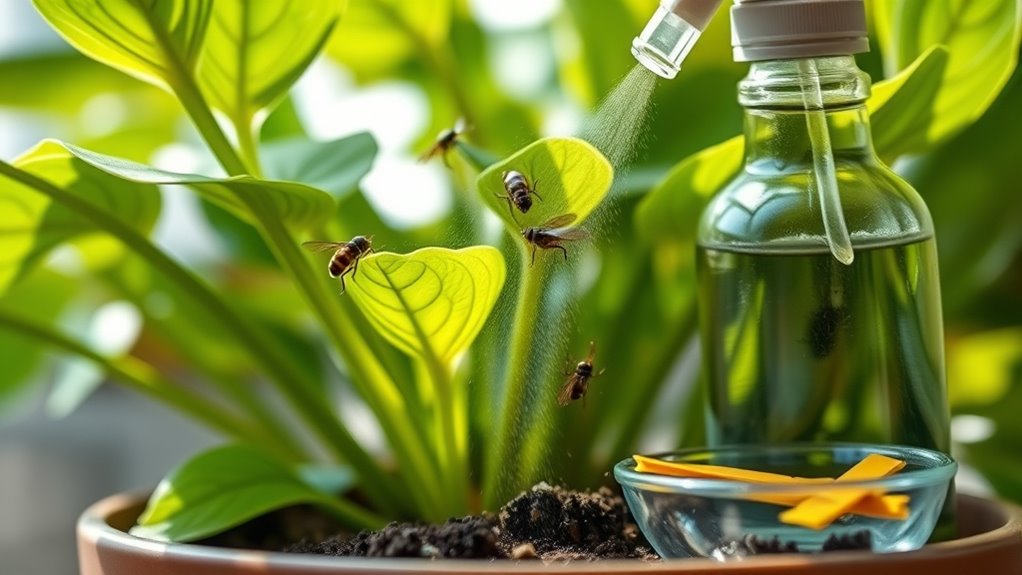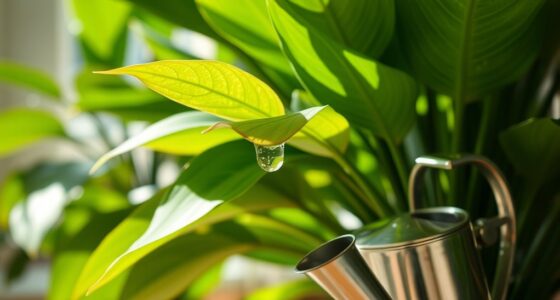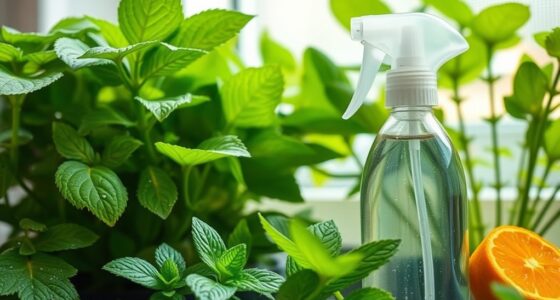To get rid of small black flies on your indoor plants naturally, start by letting the top layer of soil dry out. This disrupts larval development. Use yellow sticky traps to catch adults, and consider applying neem oil as a natural pesticide. You can also create vinegar traps to attract and drown the flies. Lastly, introducing beneficial nematodes targets larvae effectively. If you want to know more about preventing future infestations and additional tips, keep discovering!
Key Takeaways
- Allow the top layer of potting soil to dry out to disrupt fungus gnat larvae development.
- Use yellow sticky traps to capture adult gnats effectively.
- Apply neem oil as a soil drench or spray to control pest populations naturally.
- Create vinegar traps using vinegar and dish soap to attract and drown adult gnats.
- Introduce beneficial nematodes to target and eliminate larvae without harming your plants.
Identification of Small Black Flies
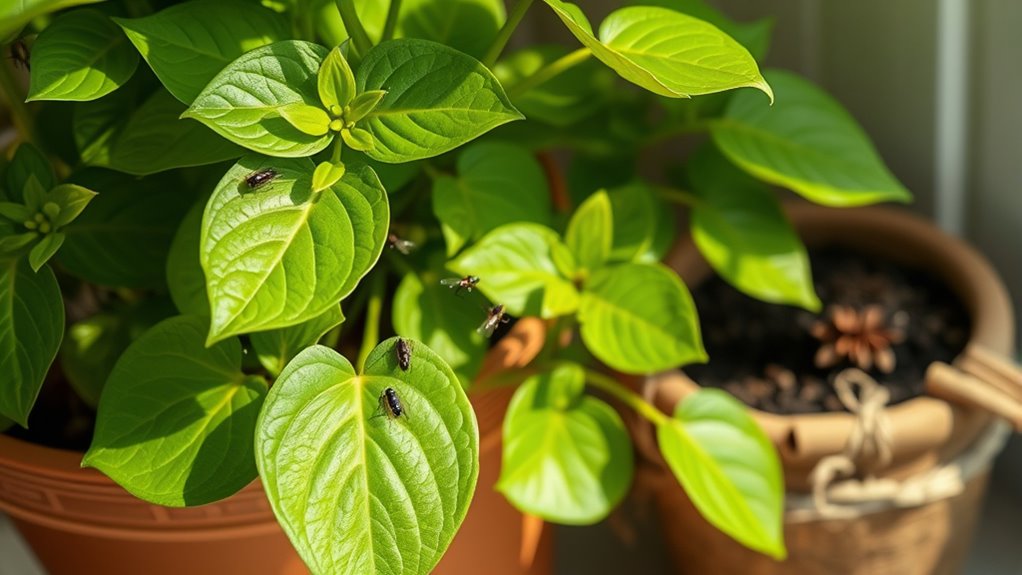
When you notice small black flies buzzing around your indoor plants, they’re likely fungus gnats, also known as mushroom flies.
These tiny pests, measuring about 3 mm in length, thrive in the moist soil of your houseplants. You might confuse them with fruit flies, but fungus gnats are generally smaller and darker. Additionally, maintaining a proper budget for your gardening supplies can help you avoid overwatering, which attracts these pests. Ensuring good color accuracy in your plant’s environment can also deter such infestations. Regular grooming can also improve your plant’s health and resilience against pests, as healthy plants are less susceptible to infestations.
The adult gnats are primarily focused on reproduction and can swarm when disturbed. Their larvae, resembling small worms with black heads, live in the top layer of the soil, feeding on fungi and organic matter, which can damage your plant roots. Infestations often occur in moist, organic-rich potting soil, making it essential to monitor soil conditions regularly.
If you spot these flies or their larvae during soil inspections, it’s a clear sign of an infestation that needs attention.
Causes of Fungus Gnat Infestation

Fungus gnat infestations often arise from a combination of environmental factors and care practices. High moisture levels in your potting mix can create a perfect breeding ground for these pests, especially if you’re overwatering your plants. Excessive moisture not only supports fungal growth, which larvae feed on, but also encourages poor drainage, leading to waterlogged soil. Additionally, the presence of organic matter like peat moss makes your soil even more attractive to gnats. Regularly checking the moisture levels of your potting mix can further prevent these infestations. Maintaining optimal moisture levels can significantly help in avoiding overwatering and fostering a healthier growing environment. Regular home cleaning can also aid in minimizing pest infestations by eliminating food sources and hiding spots. Warm indoor temperatures and high humidity levels further facilitate their development. If you bring new plants home, they might hitchhike along with the pests, increasing the likelihood of an infestation. Allowing the growing medium to dry can significantly reduce the survival of eggs and larvae. Keeping your plants healthy and monitoring moisture can help prevent these unwelcome visitors.
Natural Control Methods
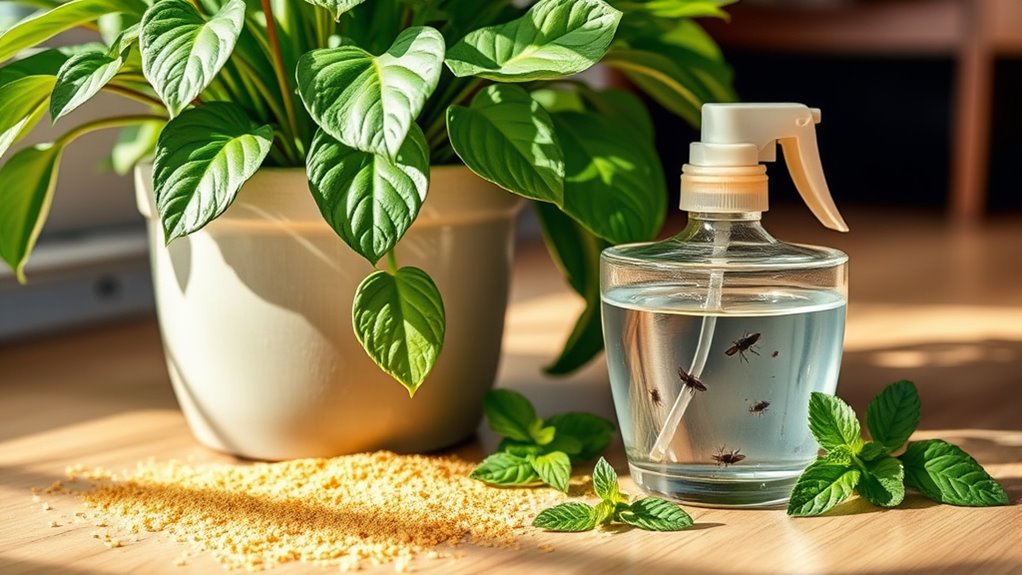
To tackle a fungus gnat infestation, natural control methods can be highly effective and environmentally friendly. Start by allowing the top layer of soil to dry out, which disrupts larvae development. Use yellow sticky traps to capture adult gnats and reduce their numbers. Neem oil, either as a soil drench or spray, disrupts their life cycle. You can also create vinegar traps by mixing vinegar with dish soap to attract and drown them. Additionally, it’s important to swap potting mix to prevent future infestations, as eggs are likely present in all pots. Consider introducing beneficial nematodes, which target larvae without harming your plants, making this approach a form of sustainable approach to pest control. Lastly, carnivorous plants like sundews can naturally consume gnats, providing a unique solution. Using self-watering pots can also help maintain optimal moisture levels, reducing the likelihood of gnat infestations.
Preventative Measures for Indoor Plants
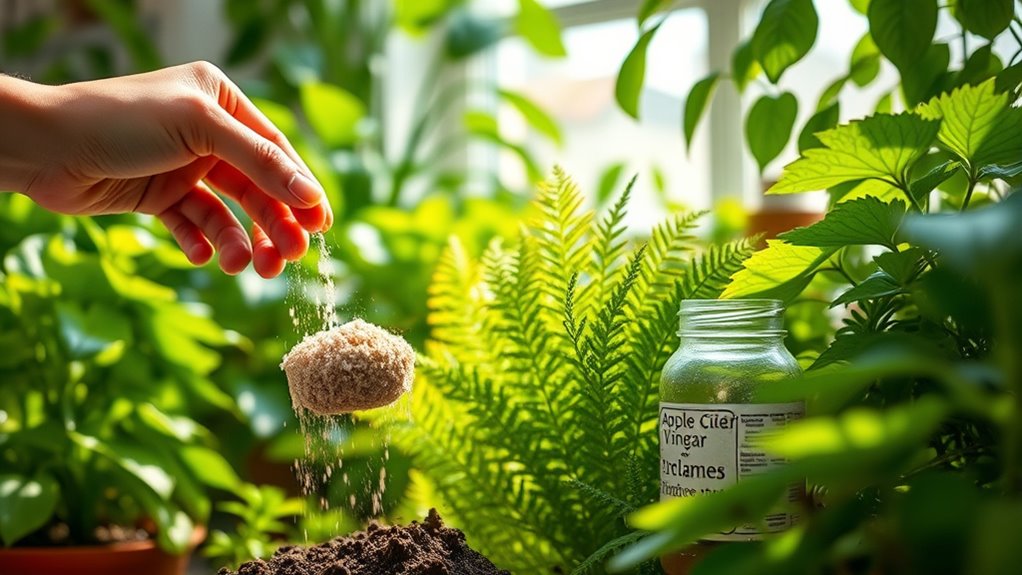
While it might be tempting to overlook the basics of plant care, implementing preventative measures is crucial for keeping your indoor plants healthy and pest-free.
Start by practicing proper watering habits; avoid overwatering and allow the soil to dry slightly between waterings. Use a well-draining potting mix to prevent waterlogged soil. Regular inspections are essential for early detection of common houseplant pests, so check your plants frequently for any signs of infestation. Strong communication skills can also be beneficial when discussing plant care with fellow gardening enthusiasts. Additionally, understanding individual responses to environmental changes can help in recognizing stress signs in your plants. Providing a nutritious diet for your plants can also boost their overall resilience against pests.
Ensure good air circulation around your plants by placing them with enough space and possibly using fans. Regularly inspect your plants for any signs of pests, checking the undersides of leaves and stem joints.
When adding new plants, quarantine them for at least two weeks to detect any hidden pests. Keeping your pots clean and sterilized also helps maintain a healthy environment for your plants.
Organic Treatments for Effective Management

If you want to effectively manage small black flies on your indoor plants, consider using organic treatments that are both safe and efficient.
Start with yellow sticky traps to capture adult gnats and disrupt their lifecycle. Introduce beneficial nematodes to target larvae without harming your plants. Neem oil works wonders as a natural pesticide, while Mosquito Bits (BTI) can be used as a soil drench to eliminate larvae. Fungus gnats thrive in house plant compost, so it’s essential to monitor moisture levels, as self-watering pots can sometimes retain too much moisture if not managed properly. In addition, understanding the importance of sustainable harvesting practices can help you maintain a healthy indoor garden ecosystem. It’s crucial to ensure that your plants are also supported by community resilience efforts to create a more sustainable environment.
For immediate action, try vinegar traps or insecticidal soap to control populations. Additionally, let the soil dry out between waterings or apply a gravel or sand mulch to deter egg-laying.
Combining these methods ensures a holistic approach to managing pesky flies naturally.
Frequently Asked Questions
Can Small Black Flies Harm Pets or Humans?
Small black flies, often fungus gnats, don’t harm pets or humans.
They’re more of a nuisance than a threat, swarming around but not causing any health issues. You won’t find evidence of allergic reactions associated with them.
While they can indicate high humidity levels in your home, their presence doesn’t pose significant risks.
How Long Does It Take to Eliminate Fungus Gnats?
It usually takes about 4 to 8 weeks to eliminate fungus gnats effectively.
You’ll need to address all stages of their life cycle, so consistency is key. Implement treatments like drying out the soil and using sticky traps regularly.
It’s wise to repeat these methods every couple of weeks to keep the population in check.
Are There Specific Plants That Attract Fungus Gnats?
Did you know that over 80% of houseplants can attract fungus gnats if the conditions are right?
While no specific plants are solely responsible for attracting these pests, they thrive in moist soil environments.
Plants with high water needs or those in humid conditions are particularly vulnerable.
You’ll want to be mindful of your watering habits and drainage to keep your plants healthy and minimize the risk of fungus gnat infestations.
Can Fungus Gnats Infest Outdoor Plants Too?
Yes, fungus gnats can infest outdoor plants too. They thrive in moist, organic-rich soil, especially in humid conditions.
You might notice adult gnats flying around or larvae in the topsoil. While outdoor plants often have natural predators that help control these pests, they can still suffer from root damage and other stress.
Regularly inspecting your outdoor plants and managing soil moisture can help prevent infestations and keep your plants healthy.
What Time of Year Are Fungus Gnats Most Active?
As the days grow warmer and the air fills with the scent of spring, you might notice tiny black flies buzzing around your plants.
Fungus gnats are most active during these seasonal transitions, especially from winter to spring and summer to fall.
You’ll spot them thriving in moist soil, where they lay their eggs.
Keeping an eye on your plant’s moisture levels during these times can help you manage their presence effectively.
Conclusion
By taking these natural steps, you can effectively manage those pesky small black flies and keep your indoor plants thriving. Did you know that a staggering 25% of houseplant owners report dealing with pests like fungus gnats? It’s a common struggle, but you’re not alone. With a little effort and the right approach, you can create a healthier environment for your plants and enjoy their beauty without the annoyance of unwanted pests. Happy gardening!

